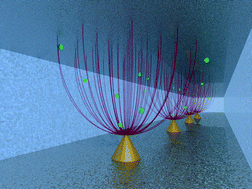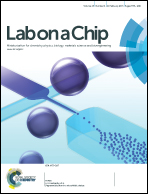Capturing molecules with plasmonic nanotips in microfluidic channels by dielectrophoresis
Abstract
Over the last decades, different concepts have been established for the use of plasmonic nanostructures in sensing applications. One challenge in this context lies in delivering the analyte of interest to the location of the nanostructures and selectively attaching it to their surfaces. Here we present a method for the collection and concentration of molecules on arrays of metallic nanocones, making use of the high electric field gradients at the nanotips. For this purpose, the nanocones are integrated into a microfluidic channel and used as nanoelectrodes. By applying an AC voltage, dielectrophoresis is used to capture molecules from the channel region near the nanocones. Simulations of the dielectrophoretic forces in the channel are presented as well as experimental proof of the proposed method. After attachment of the molecules, optical read-out techniques can directly be performed on the plasmonic nanostructures.


 Please wait while we load your content...
Please wait while we load your content...